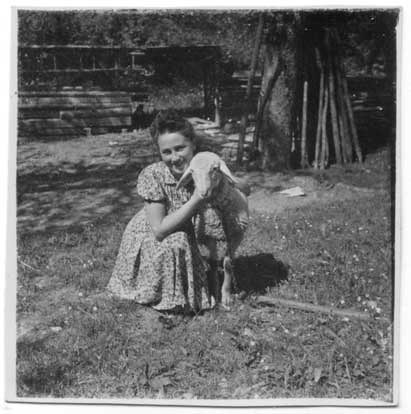For partisan groups, fighting the powerful and well-equipped German army in open combat was typically not an option. Partisans spent much of their time hiding from the enemy, and discovery of their whereabouts was a major, ever-looming threat. The Nazis used local spies, bribes, aerial surveillance, and forest sweeps to root out partisan groups hiding in the countryside, so the partisan had to constantly be on high alert.
Jewish partisans had to fear for their lives not just because they were fighting against the occupying army but because of their Jewish identity. All partisans1 had to be wary of enemy bullets, lice and typhoid, and of leaving footprints in the fresh snow, but Jewish partisans faced an added threat. For many Jews, their accent, the way they looked or dressed, their unfamiliarity with non-Jewish society, and a myriad of subtle details marked them as "other". This otherness exposed them to mortal danger – and not just from the Nazis and their collaborators, but also from unfriendly members of the Armia Krajowa, antisemitic peasants, and (if they were in a mixed otriad) even their fellow partisans. (For more information on this subject, see our Antisemitism in the Partisans E-Learning course.)
Even a doctor's oath to "do no harm" was no guarantee of safety. After being wounded, Norman Salsitz had to seek treatment from a local doctor – a known antisemite. Norman's anecdote provides a stark illustration of the ever-present danger Jewish partisans found themselves in:
[We] went to the doctor and she said, “I have somebody who was wounded yesterday. He’s from the AK,” if he will look at me. He said yes. She brought me over and he started…he said, “Let down your pants.” So I was afraid that he does it purposely to see if I’m Jewish...I took out a hand grenade and I took out the pin and I said, “If you do something I will let the pin out and we all be killed.”
Identity was treated as a matter of life-and-death – not just by the Nazis, but also by most other groups hostile to the Jews as well, such as the various ultra-right wing nationalist groups in Poland, Ukraine, and the Balkans. Though many Jews lived in their own communities, segregated from the gentile population, they were nonetheless well-known by the locals, and could frequently be singled out by their accents2, names that looked or sounded "Jewish", and appearance.
Sonia Orbuch was born Sarah Shainwald, but the commander of her otriad made her change her given name to the more common and less Jewish-sounding Russian name Sonia – to keep her safe from antisemites. “Here there are no Sarahs,” he explained to her. To keep himself out of trouble in Moscow, Leon Senders concealed his Jewish identity by simply bleaching his hair with peroxide. Likewise, Ben Kamm excelled at smuggling food through the countryside because of his blue eyes and blond hair.
Fluency in other languages helped many partisans avoid danger - particularly if they could speak without a Yiddish or foreign accent. Running away from his village after the Nazis rounded up all his classmates, 15 year old Joe Kubryk found work as a farmhand with a Ukrainian farmer who never suspected he was Jewish – all because Joe spoke fluent Ukrainian. Growing up in Metz on the northern border of France, Bernard Musmand learned to speak German in school at a young age. Later, while running dangerous missions as a courier for the Sixieme3, he used his fluency in German to dispel suspicions about his identity – usually, with a friendly request for the time or for a match.
Bernard was not only fluent in German – he was also well-versed in Catholicism, another useful instrument of disguise. When his family fled to southern France, he had to pose as a Catholic to attend the local boarding school. He was so diligent at keeping up appearances that the priests actually asked him if he was interested in going into the seminary. Leon Idas , a Greek partisan, grew up attending a private school run by the local Orthodox church. Consequently, he was able to use the religious knowledge he learned there to keep his Jewish identity secret when he joined the partisans.
, a Greek partisan, grew up attending a private school run by the local Orthodox church. Consequently, he was able to use the religious knowledge he learned there to keep his Jewish identity secret when he joined the partisans.
Though Norman Salsitz was already a partisan, joining the AK was the only way he felt he could strike an effective blow against the Nazis – to do so was the patriotic duty of any able Pole. However, he could not do so without concealing his Jewish identity. He managed to join by assuming the name (and ID card) of another AK soldier. Along with Joseph Greenblatt, Norman is one of the many Jewish partisans who worked for the AK under an assumed Christian name. Norman’s allegiances were tested when a command was given to murder a group of Jews hiding on a farm. He volunteered for the mission – after killing his Polish companions, he rescued the Jews and fled to his original partisan unit. There are many other instances of Jews infiltrating the AK under Christian identities, acquiring rank and status, and using their power to help other Jews escape persecution and death.

Left: photo on Norman's ID card; right: the real Norman Salsitz.
Nazi Germany’s plans for the occupied territories included specific methods for singling out and isolating the Jews, such as the infamous yellow badges. When Frank Blaichman smuggled food through the countryside, his preferred method of disguise was to remove the badge from his clothing and hide it until he returned home. Though it may sound simple in hindsight, such an act was punishable by severe beatings, imprisonment, and even death. He could have easily been found out - travel permits were required for even the most routine trips out of town. Frank had no official documents, but he did have a backup: his fluency in Polish allowed him to talk his way out of trouble if he was ever stopped.
smuggled food through the countryside, his preferred method of disguise was to remove the badge from his clothing and hide it until he returned home. Though it may sound simple in hindsight, such an act was punishable by severe beatings, imprisonment, and even death. He could have easily been found out - travel permits were required for even the most routine trips out of town. Frank had no official documents, but he did have a backup: his fluency in Polish allowed him to talk his way out of trouble if he was ever stopped.
The falsification of identity papers was vital to the underground. Romi Cohn was instrumental in providing Jewish refugees with false documents that identified them as Christians. The forgeries were of a very high quality – a connection at the local Gestapo headquarters supplied him with German seals to stamp the documents. Working at an employment agency in the early 1940s, Eta Wrobel used her clerical skills to forge identity papers for Jews. Even the famed mime Marcel Marceau – himself a Jewish partisan – utilized his drawing skills to make false identity cards for Jewish children.
Not surprisingly, a number of Jewish partisans served the cause as spies. Their combined skills – as forgers, as polyglots, as people used to living in a constant state of disguise – put them in a unique position. Even though he was only 15 at the time, Joe Kubryk was trained in the arts of espionage. While Leon Senders was valuable to Moscow as a radio operator, his real art was subterfuge. Leon's knowledge of German, Russian, Polish, and Lithuanian helped him fool his enemies and make new friends. He successfully built up a network of informants he used to acquire sensitive information that was instrumental in bombing the German supply lines. Wearing a tattered shepherd’s coat, Leon was so good at disguising himself he was once kicked out of a farmer’s house because a German officer, who wished to eat lunch there, objected to the presence of “Lithuanian swine” at his meal.
In a war where millions of civilians were murdered for no reason other than their identity – be it ethnic, religious, sexual, or political – the means and the opportunity to conceal and change it often meant the difference between life and death. Even the smallest adjustment could have major consequences: Leon Bakst’s father was a merchant, but when the SS asked for his occupation during the first roundup of the Jews in his hometown of Ivie, he simply answered “brush-maker”. He reasoned that the occupiers would have more use for a brush-maker than a merchant. He was correct: his life was spared that day.
1. Out of the hundreds of thousands of partisans active during the war, only 20,000-30,000 were Jewish.
2. The primary language spoken in Eastern European shtetls was Yiddish, and though not unheard of, unaccented fluency in languages like Polish or Ukrainian was not common.
3. La Sixieme was the underground incarnation of Eclaireurs Israélites, a French Jewish scouting organization. The EI went underground in 1942 and became known as the “Sixth Bureau”, smuggling children and adults into Switzerland, hiding Jews, providing forged documents, and even taking part in battles for the liberation of France.


























